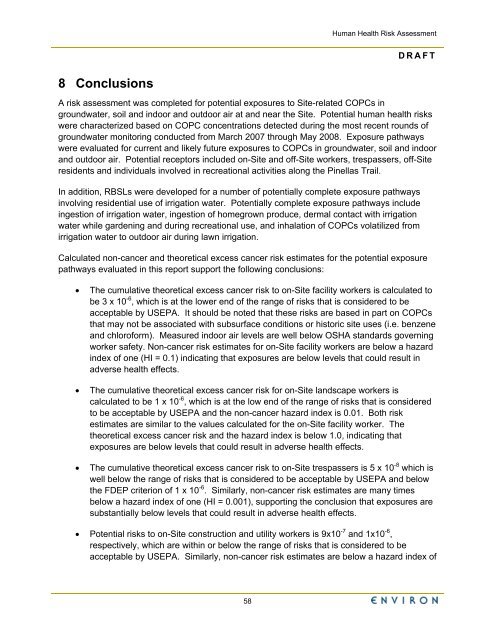Human Health Risk Assessment - Raytheon
Human Health Risk Assessment - Raytheon
Human Health Risk Assessment - Raytheon
Create successful ePaper yourself
Turn your PDF publications into a flip-book with our unique Google optimized e-Paper software.
8 Conclusions<br />
58<br />
<strong>Human</strong> <strong>Health</strong> <strong>Risk</strong> <strong>Assessment</strong><br />
DRAFT<br />
A risk assessment was completed for potential exposures to Site-related COPCs in<br />
groundwater, soil and indoor and outdoor air at and near the Site. Potential human health risks<br />
were characterized based on COPC concentrations detected during the most recent rounds of<br />
groundwater monitoring conducted from March 2007 through May 2008. Exposure pathways<br />
were evaluated for current and likely future exposures to COPCs in groundwater, soil and indoor<br />
and outdoor air. Potential receptors included on-Site and off-Site workers, trespassers, off-Site<br />
residents and individuals involved in recreational activities along the Pinellas Trail.<br />
In addition, RBSLs were developed for a number of potentially complete exposure pathways<br />
involving residential use of irrigation water. Potentially complete exposure pathways include<br />
ingestion of irrigation water, ingestion of homegrown produce, dermal contact with irrigation<br />
water while gardening and during recreational use, and inhalation of COPCs volatilized from<br />
irrigation water to outdoor air during lawn irrigation.<br />
Calculated non-cancer and theoretical excess cancer risk estimates for the potential exposure<br />
pathways evaluated in this report support the following conclusions:<br />
• The cumulative theoretical excess cancer risk to on-Site facility workers is calculated to<br />
be 3 x 10 -6 , which is at the lower end of the range of risks that is considered to be<br />
acceptable by USEPA. It should be noted that these risks are based in part on COPCs<br />
that may not be associated with subsurface conditions or historic site uses (i.e. benzene<br />
and chloroform). Measured indoor air levels are well below OSHA standards governing<br />
worker safety. Non-cancer risk estimates for on-Site facility workers are below a hazard<br />
index of one (HI = 0.1) indicating that exposures are below levels that could result in<br />
adverse health effects.<br />
• The cumulative theoretical excess cancer risk for on-Site landscape workers is<br />
calculated to be 1 x 10 -6 , which is at the low end of the range of risks that is considered<br />
to be acceptable by USEPA and the non-cancer hazard index is 0.01. Both risk<br />
estimates are similar to the values calculated for the on-Site facility worker. The<br />
theoretical excess cancer risk and the hazard index is below 1.0, indicating that<br />
exposures are below levels that could result in adverse health effects.<br />
• The cumulative theoretical excess cancer risk to on-Site trespassers is 5 x 10 -8 which is<br />
well below the range of risks that is considered to be acceptable by USEPA and below<br />
the FDEP criterion of 1 x 10 -6 . Similarly, non-cancer risk estimates are many times<br />
below a hazard index of one (HI = 0.001), supporting the conclusion that exposures are<br />
substantially below levels that could result in adverse health effects.<br />
• Potential risks to on-Site construction and utility workers is 9x10 -7 and 1x10 -6 ,<br />
respectively, which are within or below the range of risks that is considered to be<br />
acceptable by USEPA. Similarly, non-cancer risk estimates are below a hazard index of

















